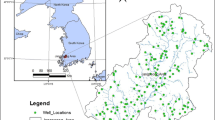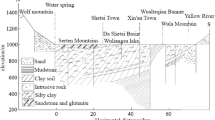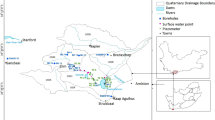Abstract
One of the most important agricultural areas in Iran is Golestan Province. In this study, the suitability of groundwater for irrigation purposes was assessed. To determine hydro-geochemical classification of the station and assessment of spatial modeling of the study area, 12 groundwater stations were selected and an average of the last 5 years of sampling (2011–2015) has been considered. Suitability of groundwater for irrigation was assessed based on Sodium Adsorption Ratio (SAR), Residual Sodium Carbonate (RSC), Na%, Permeability Index (PI), Magnesium Adsorption Ratio (MAR), Kelley’s Ratio (KR), Corrosion Ratio (CR), Residual Sodium Carbonate (RSC), Potential Soil Salinity (PSS), Chloro-Alkaline Indices (CAI), Meteoric genesis (Met. gen) and Wilcox classification. The abundance of major ions followed a HCO3 > SO4 > Na > Ca > Mg > Cl > K trend. CAI results indicate reverse cation exchange for this area, and Wilcox classification indicates that only Kalou, Kafshgari, and Kia stations are appropriate for irrigation. The spatial distribution of groundwater quality demonstrates a decreasing trend from SE to NW based on CAI, Cl, CR, EC, TSS, and TDS and shows reverse trends for KR, MAR, Met. gen, Mg/Ca, Na%, pH, PI, and RSC. In addition, the results of hydro-geochemical classification of irrigation parameters have categorized the irrigation water of this area into three different classes. Based on EC, MAR, Mg/Ca, Cl and CR, this area is suitable, but based on PSS, KR, and TH, all stations are unsuitable and according to SAR, TDS, Na% and PI, this area’s groundwater is moderate.










Similar content being viewed by others
References
Abdel Moneim AA (1988) Hydrogeology of the Nile basin in Sohag Province (Doctoral dissertation, M. Sc. Thesis, Geology Department, Faculty of Science, Assiut University, Assiut, Egypt)
Ağca N (2014) Spatial variability of groundwater quality and its suitability for drinking and irrigation in the Amik Plain (South Turkey). Environ Earth Sci 72(10):4115–4130
Alaya MB, Saidi S, Zemni T, Zargouni F (2014) Suitability assessment of deep groundwater for drinking and irrigation use in the Djeffara aquifers (Northern Gabes, south-eastern Tunisia). Environ Earth Sci 71(8):3387–3421
Alperovitch N, Shainberg I, Keren R (1981) Specific effect of magnesium on the hydraulic conductivity of sodic soils. J Soil Sci 32(4):543–554
APHA (American Public Health Association) (1998) Standard methods for the examination of water and wastewater. American Public Health Association, Port City Press, Maryland
Ayers RS, Westcot DW (1985) Water quality for agriculture. FAO Irrigation and drainage paper 29 Rev. 1. Food and Agricultural Organization, Rome
Ayoubi S, Khormali F, Sahrawat KL, Rodrigues de Lima AC (2011) Assessing impacts of land use change on soil quality indicators in a loessial soil in Golestan Province, Iran. J Agric Sci Technol 13:727–742
Chapman DV (ed) (1996) Water quality assessments: a guide to the use of biota, sediments and water in environmental monitoring. E & Fn Spon, London, p 626
Dehghani AA, Haddadchi A, Omid MH, Movahedi N (2014) Applicability of MEP and SEMEP for computing total sediment load (case study: Chelichay Catchment in Golestan Province). KSCE J Civil Eng 18(6):1912–1919
Doneen LD (1964) Notes on water quality in agriculture. Published as a water sciences and engineering. Department of Water Sciences and Engineering, University of California, paper, 4001
Doneen LD (1962). The influence of crop and soil on percolating waters. In: Proceeding of 1961 biennial conference on groundwater recharge (from Raghunath 1987)
Durvey VS, Sharma LL, Saini VP, Sharma BK (1991) Handbook on the methodology of water quality assessment. Rajasthan agriculture university, Bikaner, p 156
Edmunds WM (2003) Renewable and non-renewable groundwater in semi-arid and arid regions. Dev Water Sci 50:265–280
Foster SSD (1995) Groundwater for development: an overview of quality constraints. Groundwater quality, 17th Special Report. Chapman and Hall, London, pp 1–3
Haritash AK, Kaushik CP, Kaushik A, Kansal A, Yadav AK (2008) Suitability assessment of groundwater for drinking, irrigation and industrial use in some North Indian villages. Environ Monit Assess 145(1–3):397–406
Hopkins BG, Horneck DA, Stevens RG, Ellsworth JW, Sullivan DM (2007) Managing irrigation water quality for crop production in the Pacific Northwest. Oregon State University Extension Service, Covallis
Jassas H, Merkel B (2015) Assessment of hydrochemical evolution of groundwater and its suitability for drinking and irrigation purposes in Al-Khazir Gomal Basin, Northern Iraq. Environ Earth Sci 74(9):6647–6663
Johnson G, Zhang H (1990) Classification of irrigation water quality, Oklahoma cooperative extension fact sheets. http://www.osuextra.com
Kelley WP (1963) Use of saline irrigation water. Soil Sci 95(6):385–391
Kelly WR, Panno SV, Hackley K (2012) The sources, distribution, and trends of chloride in the waters of Illinois. In: Illinois state water survey bulletin 74, p 15
Keshavarzi B, Moore F, Najmeddin A, Rahmani F (2012) The role of selenium and selected trace elements in the etiology of esophageal cancer in high risk Golestan province of Iran. Sci Total Environ 433:89–97
Kiani AR, Abbasi F (2009) Assessment of the water–salinity crop production function of wheat using experimental data of the Golestan Province, Iran. Irrig Drain 58(4):445–455
Kleinspehn KL, Paola C (eds) (2012) New perspectives in basin analysis. Springer, Berlin
Kumar M, Kumari K, Ramanathan AL, Saxena R (2007) A comparative evaluation of groundwater suitability for irrigation and drinking purposes in two intensively cultivated districts of Punjab, India. Environ Geol 53(3):553–574
Kurdi M, Hezarkhani A, Eslamkish T (2014) Assessment of chemical properties and hydro-geochemical coefficients at the Qareh Sou Basin, Golestan Province, Iran. Environ Earth Sci 72(9):3243–3249
Majumdar D, Gupta N (2000) Nitrate pollution of groundwater and associated human health disorders. Indian J Environ Health 42(1):28–39
Mirzaei R, Ghorbani H, Moghaddas NH, Martín JAR (2014) Ecological risk of heavy metal hotspots in topsoils in the Province of Golestan, Iran. J Geochem Explor 147:268–276
Pulle JS, Khan AM, Ambore NE, Kadam DD, Pawar SK (2005) Assessment of ground water quality of Nanded City. Pollut Res 24(3):657
Raghunath HM (1987) Groundwater Wiley Eastern Ltd., New Delhi, India
Raman V (1983) Impact of corrosion in the conveyance and distribution of water. J Indian Water Works Assoc 15(1):115–121
Ramesh K, Elango L (2012) Groundwater quality and its suitability for domestic and agricultural use in Tondiar river basin, Tamil Nadu, India. Environ Monit Assess 184(6):3887–3899
Rao NS (2006) Seasonal variation of groundwater quality in a part of Guntur District, Andhra Pradesh, India. Environ Geol 49(3):413–429
Rasouli F, Pouya AK, Cheraghi SAM (2012) Hydrogeochemistry and water quality assessment of the Kor-Sivand Basin, Fars Province, Iran. Environ Monit Assess 184(8):4861–4877
Ravikumar P, Somashekar RK, Angami M (2011) Hydrochemistry and evaluation of groundwater suitability for irrigation and drinking purposes in the Markandeya River basin, Belgaum District, Karnataka State, India. Environ Monit Assess 173(1–4):459–487
Richards LA (1954) Diagnosis and improvement of saline and alkali soils. Soil Sci 78(2):154
Saleh A, Al-Ruwaih F, Shehata M (1999) Hydrogeochemical processes operating within the main aquifers of Kuwait. J Arid Environ 42(3):195–209
Sastri JCV (1994) Groundwater chemical quality in river basins, hydrogeochemical facies and hydrogeochemical modeling. Lecture notes—refresher course conducted by school of Earth Sciences. Bharathidasan University, Thiruchirapalli, Tamil Nadu, India
Sawyer CN, McCarty PL (1967) Chemistry for sanitary engineers. In: Chemistry for sanitary engineers. McGraw-Hill
Schoeller H (1965) Qualitative evaluation of groundwater resources. Methods and techniques of groundwater investigations and development. UNESCO, pp 54–83
Semnani S, Roshandel G, Zendehbad A, Keshtkar A, Rahimzadeh H, Abdolahi N et al (2010) Soils selenium level and esophageal cancer: An ecological study in a high risk area for esophageal cancer. J Trace Elem Med Biol 24(3):174–177
Sharifi Z, Safari Sinegani AA (2012) Arsenic and other irrigation water quality indicators of groundwater in an agricultural area of Qorveh Plain, Kurdistan, Iran. Am Eurasian J Agric Environ Sci 12(4):548–555
Smil V (1999) Long-range perspectives on inorganic fertilizers in global agriculture, 1999 Travis P Hignett lecture. Alabama, USA
Srinivasan JT, Reddy VR (2009) Impact of irrigation water quality on human health: a case study in India. Ecol Econ 68(11):2800–2807
Sujatha D, Reddy BR (2003) Quality characterization of groundwater in the south-eastern part of the Ranga Reddy district, Andhra Pradesh, India. Environ Geol 44(5):579–586
Todd DK (1980) Groundwater hydrology. Wiley, New York, pp 10–138
Trabelsi R, Abid K, Zouari K (2012) Geochemistry processes of the Djeffara palaeogroundwater (Southeastern Tunisia). Quat Int 257:43–55
Tripathi AK, Mishra UK, Mishra A, Tiwari S, Dubey P (2012) Studies of hydrogeochemical in groundwater quality around Chakghat Area, Rewa District, Madhya Pradesh, India. Int J Mod Eng Res Technol 2(6):4051–4059
UNEP (1990) GEMS/Water data summary 1985–1987. Burlington, Ontario, Canada Centre for Inland Waters; United Nations Environment Programme, Global Environment Monitoring System, GEMS/Water Programme Office
Wilcox LV (1955) Classification and use of irrigation waters. U.S. Depatment of Agriculture. Circ. 969, Washington, D.C
Wilcox LV (1948) The quality of water for irrigation use (No. 170282). United States Department of Agriculture, Economic Research Service
Wilkinson WB, Edworthy KJ (1981) Groundwater quality monitoring systems—Money wasted? Sci Total Environ 21:233–246
Yadav JSP, Girdhar IK (1981) The effects of different magnesium: calcium ratios and sodium adsorption ratio values of leaching water on the properties of calcareous versus noncalcareous soils. Soil Sci 131(3):194
Zaidi FK, Nazzal Y, Jafri MK, Naeem M, Ahmed I (2015) Reverse ion exchange as a major process controlling the groundwater chemistry in an arid environment: a case study from northwestern Saudi Arabia. Environ Monit Assess 187(10):1–18
Acknowledgements
We are thankful to the Regional Water Organization of Golestan Province for providing the data and allowing its use.
Author information
Authors and Affiliations
Corresponding author
Rights and permissions
About this article
Cite this article
Kurdi, M., Eslamkish, T. Hydro-geochemical classification and spatial distribution of groundwater to examine the suitability for irrigation purposes (Golestan Province, north of Iran). Paddy Water Environ 15, 731–744 (2017). https://doi.org/10.1007/s10333-017-0587-x
Received:
Revised:
Accepted:
Published:
Issue Date:
DOI: https://doi.org/10.1007/s10333-017-0587-x




